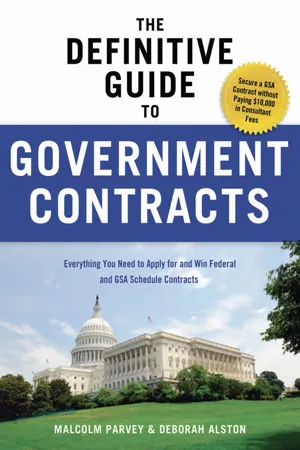
The Definitive Guide to Government Contracts
Everything You Need to Apply for and Win Federal and GSA Schedule Contracts
- 240 pages
- English
- ePUB (mobile friendly)
- Available on iOS & Android
The Definitive Guide to Government Contracts
Everything You Need to Apply for and Win Federal and GSA Schedule Contracts
About This Book
The U.S. government is the biggest customer in the world! How can your small business get a piece of the pie? The Definitive Guide to Government Contracts begins at the beginning, and assumes no prior knowledge of the government marketplace. Written in a clear, easy-to-understand language by experienced sales and marketing professionals, it takes you through every step of the process—finding the opportunities; understanding the requirements; registering your company and submitting your bid; shipping, packaging, and invoicing requirements.The same step-by-step approach is used to explain the increasingly popular GSA contract, from researching the schedules, preparing the paperwork, and submitting your proposal, to the all-important marketing that is required once the contract has been awarded. Thinking about selling to the federal government but don't know where to begin? The Definitive Guide to Government Contracts is all the help you need.
Frequently asked questions
Information
Chapter 1
Introduction to Federal Government Sales
Overview
Are You a Small Business?
Resources
How the Federal Government Buys What It Needs
Important Codes and Numbers
Are You a Small Business? Determining Size Standards
Construction | • General building and heavy construction contractors: $33.5 million. • Special trade construction contractors: $14 million. • Land subdivision: $7 million. • Dredging: $20 million. |
Manufacturing | • About 75 percent of the manufacturing industries: 500 employees. • A small number of industries: 1,500 employees. • The balance: either 750 or 1,000 employees. |
Retail Trade | • Most retail trade industries: $7 million. • A few (such as grocery stores, department stores, motor vehicle dealers, and electrical appliance dealers), have higher size standards, but none above $35.5 million. |
Services | • Most common: $7 million. • Computer programming, data processing, and systems design: $25 million. • Engineering and architectural services and a few other industries have different size standards. • The highest annual-receipts size standard in any service industry: $35.5 million. • R&D and environmental remediation service industries state size standards as number of employees. |
Wholesale Trade | • For small-business federal contracts: 100 employees. • You must deliver the product of a small domestic manufacturer (unless this is waived by the SBA for a particular class of product). • For procurements less than $25,000 you may deliver the goods of any domestic manufacturer. |
Other Industries | Divisions include agriculture; transportation, communications, electric, gas, and sanitary services; and finance, insurance, and real estate. Because of wide variation in the structure of industries in these divisions, there is no common pattern of size standards. |
Resources for Small Businesses
How the Federal Government Buys What It Needs
Micro-Purchases
Invitation For Bid (IFB)—Sealed Bid
Request For Proposal (RFP)—Negotiated Bid
Request For Quotation (RFQ)
Table of contents
- Cover Page
- Title Page
- Copyright Page
- Contents
- A Word From the Authors
- Introduction: The 25 Biggest Misconceptions About Federal Contracting
- How to Use This Book
- Chapter 1 Introduction to Federal Government Sales
- Chapter 2 Searching the Federal Business Opportunities Website
- Chapter 3 Electronic Quoting: The Defense Logistics Agency’s Internet Bid Board System (DIBBS) Website
- Chapter 4 Additional Procurement Sites
- Chapter 5 Step By Step Through a Typical Solicitation Document
- Chapter 6 Service Contracts
- Chapter 7 Fulfilling the Terms of Your Contract
- Chapter 8 An Introduction to the GSA Contract
- Chapter 9 Preparing Your Submission
- Chapter 10 After the Award
- Appendix
- Index
- About the Authors